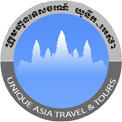Preah Ko
|
The Shiva-temple Preah Ko ("Sacred Bull") in Angkor's predecessor capital Hariharalaya - nowadays called Roluos - is located halfway between the similar Lolei temple and the pyramidal structure Bakong. It is the first ancestor temple of the Khmer empire. Preah Ko was consecrated in 879, supposedly as a kind of royal chapel adjoined to the king's palace. The residential area was surrounded by a moat of 500 m length and 400 m width. The palace buildings were wooden and vanished in the course of time, thus only the stone buildings of the temple area are left over. Preah Ko is famous for its exquisite decoration, inspiring the later Angkor styles of stone carving. Particularly, its carved colonettes remained to be of unsurpassed quality.
Preah Ko has entrance gates called Gopurams at the east and west side, the main entrance is from the east. In between the outer and the inner enclosure walls of the temple area there were rectangular buildings called galleries, and in the south-east corner an extraordinary and well-preserved square building of unknown function, maybe a predecessor of those later Angkor edifices called libraries. It has windows with brick grills, which supposedly were ventilation holes, and rows of figures of ascetics in niches above them. In front of the six central brick towers on a shared single sandstone base there are remains of three kneeling bull sculptures facing them. They show Nandi, the mount of Shiva. The temple's modern name "Ko" is the Khmer word for a bull. The central main shrines are arranged in two rows of three Prasats, but, surprisingly, the ground plan is not symmetrical, the distances between towers vary. The three eastern towers commemorating the male ancestors of King Indravarman I (877-899) are larger than those for the females behind them. Preah Ko was a Shiva and an ancestor temple at the same time. The six Prasats were dedicated to Shiva and his consort, but instead of symbolic phalli called Lingas representing this god in most other Shiva temples of the ancient Khmer civilization, images of manifestations of Shiva and of his consort were placed inside the shrines. By inscriptions on the door jambs we know, the ancestor or predecessor honoured in each Prasat was associated with the male of female deity respectively. Accordingly the guardian sculptures called Dvarapalas of the eastern towers are male, those of the western towers are females called Devatas. The outer walls of the six brick Prasats were partially covered with stucco. Preah Ko is famous for the carved decoration on the lintels and columns of the doors and false doors. (A lintel is the beam spanning the gap between the two posts of a door.) The hanging garlands are a characteristic of the so-called Preah Ko style (Roluos period, reign of King Indravarman I). Typical features of Khmer relief art are those grotesque monster-masques, called Kalas, spewing foliage from their mouths twisting on both sides and ending in mythical animals called Makaras or in serpent heads called Nagas. In Indian art these Kala-Makara-bows are symbols of fertility and abundance of water. This may be a reminder: One main task and function of a king was to secure water supply. Indravarman and his successor Yashovarman served this purpose by building a nearly 4 km long tank - now dried up - once called Indratataka, the Baray of the Lolei Temple. The best time to visit Preah Ko in Roluos is the early morning, without doubt. The Angkor ticket is valid in Roluos. It will be checked at the entrance of Preah Ko. |
